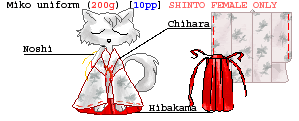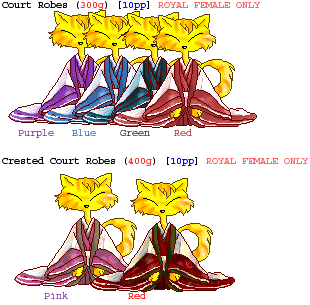|
|
|
|
|
|
|
|
|
|
|
|
|
|
|
|
|
|
 Posted: Thu Jul 29, 2004 1:05 am Posted: Thu Jul 29, 2004 1:05 am
 |
 |
 |
 |
Samurai Path:

Samurai only clothing:

Samurai only furniture:

Up till the late 18th century in Japan, Samurais were the warrior class in Japan. They fought under their respective masters (those without masters were disgraced, termed 'Ronin'), and occupied the upper echelon in society. Bearcats and royalty were also learned in the art of Bushido. During the peaceful time of isolation during the Tokugawa period, Samurais served as bearcats rather than warriors, but as Japan was plunged into turmoil by the changing tides of history, and vicious clan wars, Samurais take up their swords once again, to fight for what they believe is the better future for Japan.
Rooky:
Description: A young student who has taken to study Bushido under a Sword Master.
Obligation: Students must observe the teachings of their Master and the actions of senior students and Samurai. Their rank is a humble one, and they must give respect to all those above them, using honourifics such as '-sempai' and '-sama'. It is not unusual for students to take on the daily tasks in their Dojo, such as the laundry and cleaning. This depends on the master.
Samurai:
Desription: After many years of rigorous training, a student graduates and becomes a lawful Samurai under Tokugawa Law, and is allowed to carry two swords.
Obligations: They must be loyal to the clan or master they serve, and carry out the will of the clan leader or their master without question. It is also their duty to keep the peace. They command respect over lower ranking members of the Class, and over all members of other classes apart from the Shinto and Royalty.
Battousai:
Description: A senious Samurai who has mastered the art of Battoujitsu, the art of drawing the sword and killing in one move.
Obligations: Their obligations remain the same as those of a Samurai.
Hitokiri:
Description: Assassins, a select phew trained and perfect killers selected by the clan leader or master, who often become the clan leader or master's personal body guard. They are dispatched to perform the most delecate opporations, such as political assassinations and other similar purposes.
Obligations: They must keep their true identity hidden at all times, because Hitokiri are considered secret weapons, and are often the first to be targeted when an attack is planned.
Sword Master:
Description: Those who are experienced enough to become commander of their own division of warriors, or become instructors of Bushido in their own school.
Obligations: They must observe Samurai Values strictly to set and example for those of lower ranks. It is their job to bestow wisdom and skills upon all ranks below them.
War Lord:
Description: Very experienced Samurais may be given land and an army by their master, or the Emperor, and they become Masters themselves, under whom other Samurais must serve.
Obligations: War Lords are given command over their land and the citizens which live on it. They must rule wisely and be loyal towards the Shogunate. They will also be intrusted with dealing with issues concerning the nation, and be called to the Shogun's parliament.
Alternative Branch:
Young Rurouni:
Description: A Battousai may chose to become neutral to all clans and sides without being dubbed Ronin, because of the respect they have earned with their experience. They become 'wondering samurai'.
Obligations: They relinquish their position of superiority and are considered a commoner in the eyes of the law. They are permitted to carry only one sword. Most rurouni who have vowed to never kill again choose to carry a Sakabatou, a sword with the blade backwards.
Powerful Rurouni:
Description: A hitokiri who choses to become neutral, or a young rurouni who has gained wisdom with years. Skill wise they are on the same level as Sword Masters.
Obligations: Despite their skill level, they have no advantage socially according to law. However, they are widely revered by all classes and ranks, including high ranking Samurais. Most rurouni choose to lead a life still adhering closely to Samurai Values, and to uphold justice.
|
 |
 |
 |
 |
|
 |
 |
|
|
|
|
|
|
|
|
|
|
|
|
|
|
|
 Posted: Thu Jul 29, 2004 1:07 am Posted: Thu Jul 29, 2004 1:07 am
 |
 |
 |
 |
Artisan Path:

Artisans were considered the next class under Samurai. They included a wide range of professions including weaponry, pottery, builders, performers and geisha. Historically they were required predominantly to cater for the Samurai class.
Female path:
Waitress:
Description: A young girl employed as a waitress at a restaurant or ochaya.
Obligations: Duties as a waitress to server customers and clean after them. Only polite and hard working waitresses have a chance of being taken on to be a Maiko.
Maiko:
Description: Novice Geisha, studying under a Geisha.
Obligations: To observe the teachings of their Geisha and wait on their Geisha Master in the same way as a maid. They may continue their duties in their previous employment.
Geisha:
Description: After some years of study under a Geisha, they become one themselves. They are learned in all domestic arts, including cooking, performing the tea ceremony, flower arranging, dance, and the art of entertaining and conversation.
Obligations: To entertain customers who visit their Ochaya by serving the tea and food, and providing interesting company.
Court Attendant:
Description: Highly respected Geishas are admitted to the Royal Court.
Obligations: Serve the royal family, and in return enjoy the respect of belonging to the Royal Court.
Male Path
Kabuki Student:
Description: A student studying in the art of Kabuki, the traditional Japanese theatre form.
Obligation: They are often employed as stage men, and attend to Kabuki Extras and Kabuki Heroes.
Kabuki Extra:
Description: Those with enough experience and showing acting talent may be allowed to become an extra in a Kabuki play.
Obligation: They enjoy superiority over Kabuki Students, however show respect to Kabuki Heroes.
Kabuki Hero:
Description: The star of the Kabuki company, widely loved, often the subject of artwork, and very well paid.
Obligation: Teach Kabuki students and Kabuki Extras the art of Kabuki.
Court attendant: See above.
|
 |
 |
 |
 |
|
 |
 |
|
|
|
|
|
|
|
|
|
|
|
|
|
|
|
|
|
|
|
|
|
|
|
|
 Posted: Thu Jul 29, 2004 1:10 am Posted: Thu Jul 29, 2004 1:10 am
 |
 |
 |
 |
Shinto Path:

Shinto only clothing:


Shinto is the national religion in Japan, based on the idea of 'Kami' or God, which is personified in all natural things, such as trees and stones. The ideal for Shinto is purity, and so you must do such things as wash your hands before entering a Shinto shrine etc. State Shinto has always been used by Japanese governments as a way of uniting the people under a common belief.
Miko:
Description: Young shrine maidens.
Obligations: Wait on priests and assisting them in ceremonies such as weddings.
Gonnegi:
Description: Junior Priest under training.
Obligations: Similar to those of a Miko.
Negi:
Description: Experienced Junior Priests become Senior Priests.
Obligations: In charge of the teaching of Junior Priests, Miko and Goneggi, as well as assisting the Guji in ceremonies.
Guji:
Description: The head priest of a particular shrine.
Obligations: Commands all those lower in the Shinto rank, and is in charge of conducting ceremonies.
Daiguji:
Description: Supreme priest under Saishu at Ise no Jingu.
Obligations: Commands over all the Shinto shrines in Japan, and assist the Saishu.
Saishu:
Description: The highest religious official in Ise no Jingu. In ancient times this position was held by an unmarried imperial princess, but the position holder is now traditionally a representative from the Bureau of Divinities (Jingikan).
Obligations: The highest authority in religious matters, adviser to the Royal family, and the guardian of Ise no Jingu, which shrines the imperial ancestress Amaterasu Ômikami, the Sun Goddess.
|
 |
 |
 |
 |
|
 |
 |
|
|
|
|
|
|
|
|
 |
|
|
|
|
|
|











